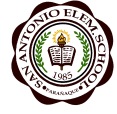GRADE THREE LAC SESSION – DIGITAL ELLN MODULE 3 LESSON 1
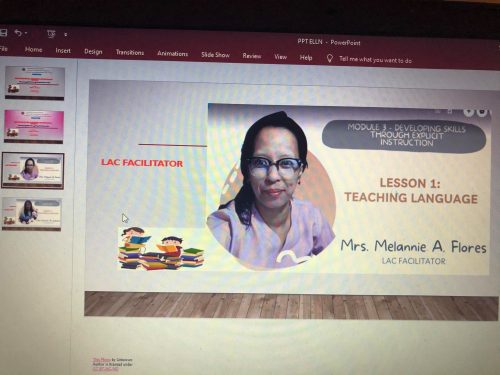
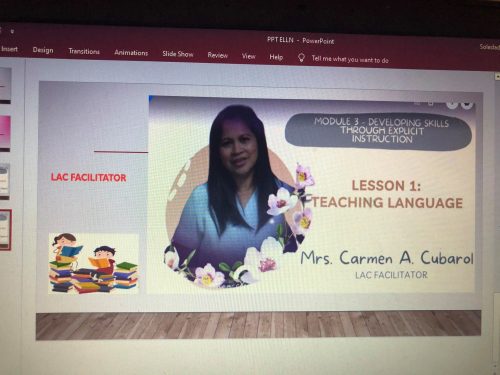
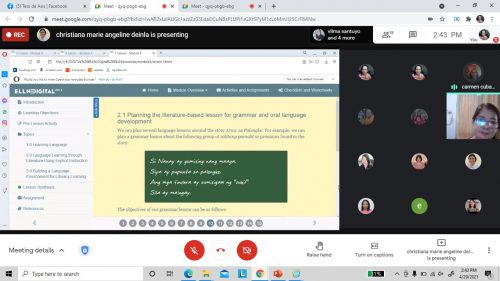
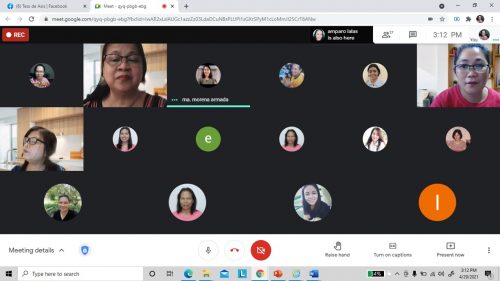
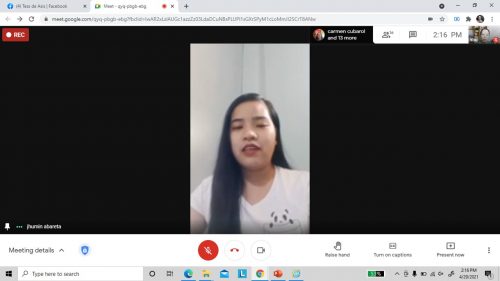
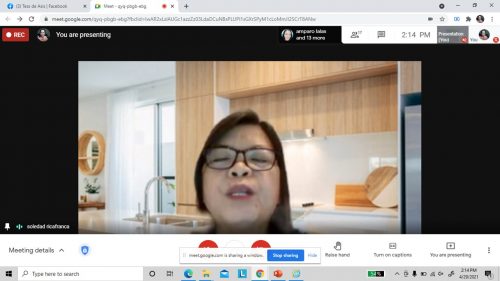
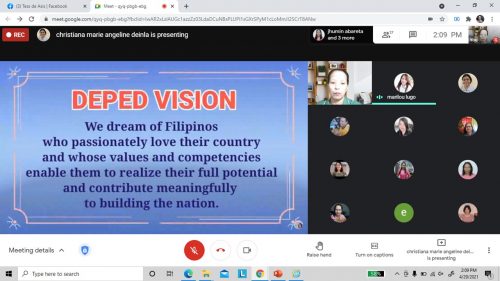
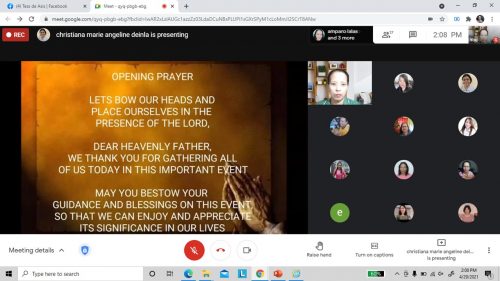
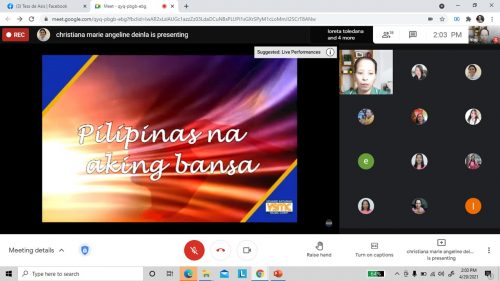
The LAC Session started at exactly 2:00 P.M. with the singing of a National song and was followed with an opening prayer which taken cared of by Ma’am Angel Deinla and Ma’am Imelda Taguines. The recitation of the Vision, Mission and Core values of the Department of Education was led by Ma’am Marilou Lugo.
Ma’am Soledad R. Ricafranca, one of the grade three master teachers gave her Welcome Remarks which was followed with a message by our grade level chairman, Ma’am Jhumin Abareta. Both gave an overview of the DAP ELLN program and enjoined everyone that together we work for the benefit of our learners and achieve the goals and objectives of the said program.
The topic for Module 3, Lesson 1 was about Language Learning. The first LAC facilitator was Ma’am Melannie A. Flores. She gave a brief recall of the previous modules which were already done by the teachers. She then started the session proper with the learning objectives: discuss the reciprocal relationship between language and literacy, plan a literature-based lesson for grammar and oral language development based on the principle of explicit instruction and build a language-rich environment to develop children’s literacy skills. Then, she presented the Pre-Lesson Activity about language learning and literacy development which everyone needed to answer. She informed the group that their answers to this activity might be changed once the discussion of the lesson 1 module has been done. This might be due to what they learned from the discussion. She further discussed how children learn a language from infancy to their preschool years. Children begin learning by first getting acquainted with their world. Babies learn receptive skills as they listen and watch other people label their world. Young children learn language from the people they interact with daily. Preschool children experience a surge of language learning and they begin to use it in a more creative manner like sharing their imaginations. Ma’am Flores further discussed that learning a language is reciprocal, the more experiences one has, the more one can share with others. We learn from talking to others and listening to responses. The more opportunities to interact, the more opportunities to learn the language. By learning language orally, we also learn language by reading written text. The last topic she discussed was about Language Learning using the explicit instruction. Explicit instruction is a structured and systematic way of teaching a skill with different parts and steps to follow. She further discussed the different features of this kind of instruction like providing support, opportunity to organize content, opportunities to observe and perform a skill, and can be used in a variety of contexts.
The second LAC facilitator was Ma’am Carmen A. Cubarol. She started her discussion with a brief recall of what explicit instruction was. She reiterated the features of this kind of instruction in preparation of her main topic on how to create a literature-based plan in teaching grammar and oral language development. She also recalled the important parts of a plan using the explicit instruction: Topic and objectives, Introduction, Presentation and Modelling, Guided Practice, Independent Practice and Evaluation. She started her discussion by sharing to the group that language lessons can be made around a certain type of literature like a short story. She presented to the group the example of the grammar lesson using the story Araw sa Palengke where pronouns, mga salitang pamalit are found in the story. Objectives on language structure or the grammar lesson were presented. It was suggested that the objectives should also include provision for oral language development which means objectives that develop skills and knowledge that go into listening and speaking which has a strong relationship to reading comprehension and to writing. After constructing objectives for grammar and oral language development, the next step was tackled. It was about Introduction to the new lesson where excerpts from the story could be used as a starting point for the lesson. It is now the task of the teacher to read sentences from the story while the children follow along in the class. Then the next step follows, the Presentation and Modelling where teacher presents the lessons, examples given are deconstructed and analyzed for the children to fully understand the lesson of the day. Teachers’ ability and skill in asking questions will matter for the children to fully understand the lesson. Other examples should also be used to further explain the lesson to the children. Once the lesson has been fully understood, it is time for the generalization of the lesson where pupils will once again be reminded of the lesson and how the language structure is to be applied. The opportunities of the children to use the language orally should not be forgotten by the teacher. After this step, the Guided practice follows where the learners are given the opportunities to apply the generalization with the assistance of the teacher. Activities provided should provide for these opportunities. Then, Independent Practice/Application follows, where the learners are given the opportunities to apply the generalization on their own and the learners should be given the opportunity to speak using the language structure. It is recommended that teacher finds time to listen to each child speak. The final part is the evaluation part where each child is given an activity/exercise for the application of the language structure. This will give the teacher the idea if he has achieved the lesson of the day or there is a need for reteaching. Evaluation part could be worksheet-based or performance-based. In closing, Ma’am Cubarol shared with the group, The more opportunities we give for the children to use the language, the higher the opportunities of learning the language. The challenge is for all the teachers. The last part that was discussed was about building a language environment for literacy learning where the use of the Mother Tongue was given emphasis as a way of acknowledging cultural identity and allowing the children to freely express themselves to be fully heard. It should also be used when communicating with others
and make it a part of a daily routine. Constant practice helps a lot in learning a language. Exposing the children to enjoyable language materials and activities, providing opportunities to use language in creative ways like in dialogs, role plays, story-telling, role playing and many more and allowing children to share their experiences contribute to an environment for kids to literacy learning making communication meaningful.
The closing remarks was given by Ma’am Soledad Ricafranca in behalf of Sir Ching who was attending a webinar.
Special thank to Ma’am Angel Deinla who took charge of presenting the slides for the LAC facilitators. Sir Marvin Geraneo, the moderator, congratulated everyone for the success of the activity. He ended it with a quote from Ken Robinson, “Teaching is a creative profession, not a delivery system. Great teachers do pass on information, but what great teachers also do is mentor, stimulate, provoke and engage.”
The session ended at 3:40 P.M.
– Mrs. Carmen Cubarol & Mrs. Lannie Flores – Grade 3 Teachers
